Why We Invested: ManageXR
Bringing the metaverse to enterprise.
More and more people are turning to extended reality (XR) as a key tool in the operation and growth of their organizations. XR is being used by corporations to train employees, by doctors to treat patients and by schools to teach students. However, they face significant hurdles in expanding their operations from early-stage pilots to organization-wide solutions.
XR is an umbrella term that covers VR (virtual reality), AR (augmented reality) and MR (mixed reality). As people move towards mass XR adoption in the enterprise space, they’re looking for full-fledged solutions to help manage and scale their XR deployments. ManageXR built the solution with their enterprise level management layer for XR devices.
The company has experienced rapid growth since becoming available to beta users in late 2019 and officially launching in 2021. ManageXR currently has over 100 customers, and they have facilitated more than 200,000 sessions-to-date across thousands of VR and AR devices. The company also recently partnered with Pico Interactive to preload ManageXR on all Pico devices in the U.S.
We’re thrilled to lead ManageXR’s $4 million series seed. The financing will be used to support ManageXR’s expanding team and go-to-market strategy. Below are a few questions with Founder and CEO Luke Wilson and Rally Venture Partner Jay Borenstein, who is joining the board of ManageXR.
1. How do you know Luke and why did you invest in ManageXR?
Jay Borenstein, Venture Partner, Rally Ventures: I first got to know Luke during his time as a student at Stanford (editor’s note: Jay is a lecturer of computer science at Stanford). He stood out for his substantial academic capabilities, as well as for his consideration of others and his desire to make a positive impact in the world.
It’s noteworthy that he spearheaded a Virtual Reality software development course, designing all the content from the ground up and delivering lectures as an undergraduate, which is rare at Stanford. I’ve also watched Luke persevere through difficult situations, handle them with class and turn them into positive experiences when many people would not be able to see it that way.
These experiences give me supreme faith in Luke’s mettle as well as his technical acumen. I’ve seen him show all the best qualities of a leader and innovator, so I was very pleased to support him as he started down the road of founding his own company. I’m very excited to support Luke as he accelerates how corporations can manage and benefit from XR devices at scale.
2. What core problem is ManageXR solving?
Luke Wilson, Founder and CEO, ManageXR: Right now, it’s really challenging for businesses to take advantage of XR. It’s an entirely new technology that affords new workflows and methods of communication, but it’s hard to take advantage of this new technology because there are certain barriers to using it at scale. You’re going to need a lot of hardware if you’re a business that wants to take advantage of XR. Which means you’ll need to keep track of all the hardware, keep it up-to-date and troubleshoot any issues.
ManageXR is an enterprise level device management platform designed for VR and AR devices that enables businesses to remotely control every aspect of their XR device fleet, including distributing apps and files, customizing the home screen user experience, tracking device health and usage and much more. We are the difference of whether or not a company can take advantage of XR at scale.
3. Why is the ManageXR team the best team to solve this problem?
We have a unique combination of XR expertise and experience. Four years ago, we were the type of company that we now support. Prior to founding ManageXR, I worked in hospitals with medical professionals developing content for XR devices, and I learned first-hand all of the challenges of using XR for business purposes at scale.
As companies use XR to solve problems, they need flexible and reliable infrastructure that helps them get the job done. Things like distributing content, managing software updates and customizing user experiences become overwhelming when you’re dealing with hundreds or thousands of devices. And as more XR devices become available in the market every year, organizations need the freedom to choose the best hardware for the job, rather than being locked in to a specific vendor. We had to solve those challenges for ourselves, and, in the process, we realized that every other company like us would have to solve the same problems on their own unless a company like ManageXR existed. Our team understands the challenges of using XR at scale on a deep, personal level, and it’s made a huge difference in how we operate the company.
4. ManageXR is rapidly growing and recently onboarded Brinks and XRHealth, both global enterprises. How is XR changing the way people conduct business?
Brinks and XRHealth are both great examples of how companies can get clear ROI from using XR in their business. Brinks uses XR devices when training their front line employees who are servicing ATMs. It makes the entire experience much safer when you can begin training novices in an XR device as opposed to using real ATMs out in the field.
Another great training example is how doctors can now use XR to learn different surgical procedures, instead of using a cadaver or being in the operating room. It allows you to start and learn in a much lower stakes situation before moving into real world environments.
XRHealth is a virtual clinic that powers home patient care with Virtual Reality (VR). Patients are able to receive guided physical therapy sessions without having to be physically present in a clinic. Patients sign up to be part of a therapeutic clinic, and then they receive a VR headset in the mail. There are so many benefits in that patients don’t have to travel or spend time in a crowded clinic, which is especially important now with pandemic concerns. The content is also gamified, which makes therapy less tedious and more fun.
Another great example of training simulations, which can cost thousands of dollars to run every single time, is pilot training. We have pilots who are learning to fly planes, each with different cockpits and procedural processes. Rather than building a fake cockpit or driving someone out to an actual plane, pilots can train in a headset. The ROI on these types of trainings is huge. It takes up a lot less time and money, while making it safer and more accessible.
5. How do you think about building a strong team in a virtual space? How can XR facilitate connection and collaboration in a remote world?
Building a strong company culture has always been really important to me, and it’s been on my mind a lot as our team continues to grow. This morning, my whole team played mini golf together. We had people from around the world — Taipei, India, the US — join a virtual world and play mini golf. We were able to have an off-site together in the middle of the day, and we had a ton of fun together.
People are always looking for new communication and collaboration tools, and XR is a fantastic tool. The key difference for VR is presence. Even though the other people are avatars and it’s not as real as being in person, it’s much further along the spectrum than being behind a computer screen. There’s a very cool element of presence in VR that you don’t get with any other technology.
Having those three dimensions is also super powerful for work and collaboration. For example, if you’re an auto maker and you’re designing cars, you’re working with three dimensional objects on which you need to collaborate. Instead of sending files between computers and looking at them on a flat screen, you can put on a headset and be in a room together walking around a three dimensional car.
VR is increasingly being used as a powerful sales tool. Real estate and fashion sectors are at the front of a curve that is broadening to include almost every business vertical. Companies will send VIP customers a headset and they can look at physical products together. XR is on the cusp of being ready for everyone, and it’s a really exciting time to be building this company.
6. What companies or leaders do you admire? What learnings from their experiences have you applied to building ManageXR?
Professionally, I’m most inspired by companies like Patagonia. Companies who build quality products and are very dedicated to their craft and mission. For example, this past Black Friday Patagonia donated all their sales to grassroots environmental organizations. They’re a shining example of how a business can have great products and also be a source of good in the world.
In my day-to-day life, it’s really the people around me who I admire and learn from the most. I come from a big family and a tight knit group of friends, and these communities have impacted the way I build companies. One of the phrases I think about a lot as we ramp up hiring is “If you want to go fast, go alone; but if you want to go far, go together.”
We’re putting a lot of focus on people as we build ManageXR. We will continue to surround ourselves with people we work well with and people who inspire us as we build the team. And I couldn’t be more inspired by the people we have on the team so far.



